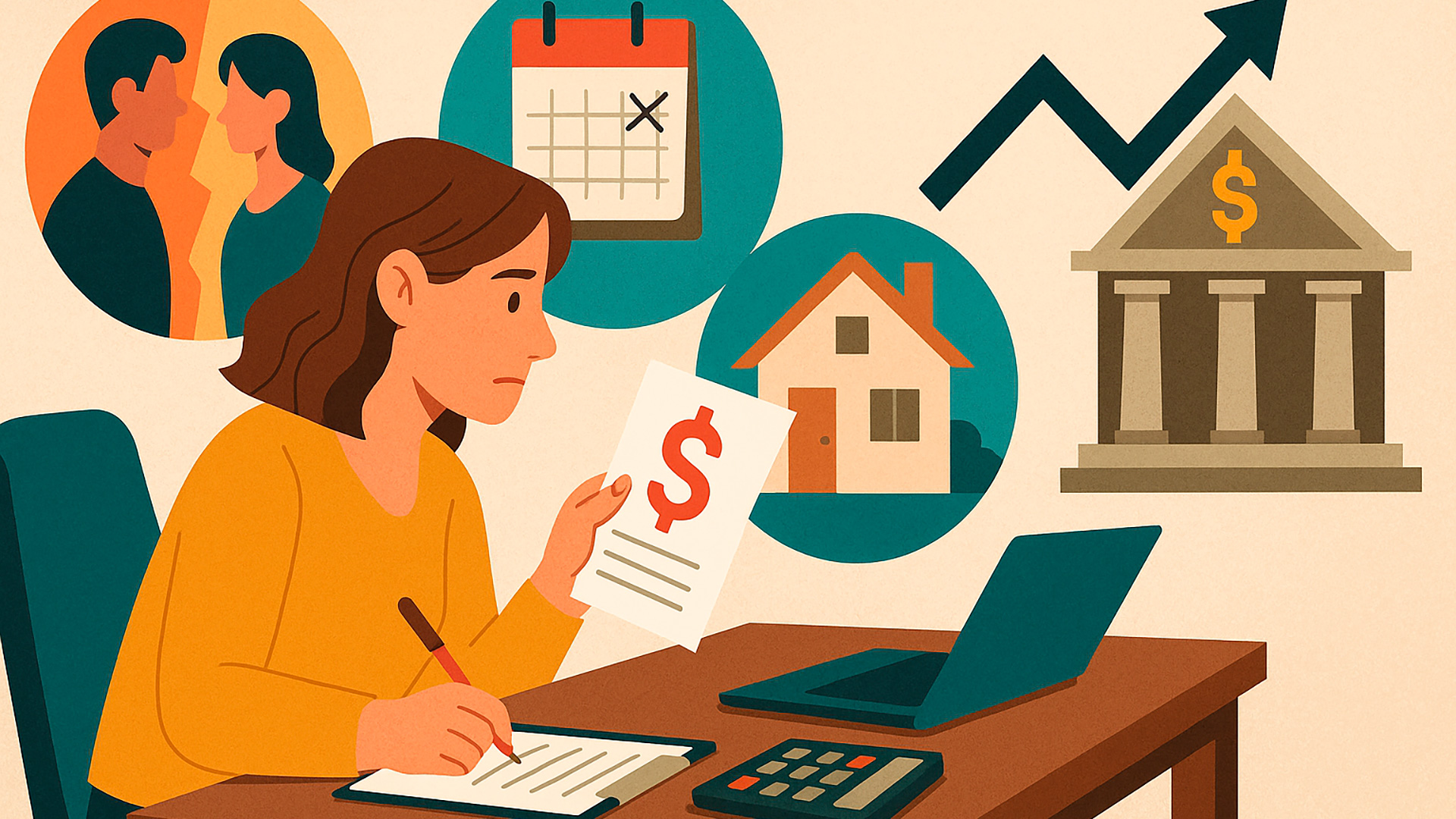Adapting Your Financial Game Plan: Staying Strong When Life Reshapes Your Credit Power

Life rarely follows a straight path. One year you might have a stable job and predictable income, and the next you’re starting over — after a move, a layoff, or even a major life change like a divorce. These transitions can shake up your finances and, in turn, your ability to borrow. That’s why knowing how to improve borrowing power when circumstances shift isn’t just a skill — it’s a form of self-protection. Whether you’re rebuilding stability or planning for the next step, the right adjustments can keep lenders confident in you and your goals within reach.
Why Borrowing Power Isn’t Fixed
Your borrowing power — the amount and quality of credit you can access — depends on far more than your income. Lenders look at how you manage obligations, how much debt you carry, your credit score, and even how consistent your financial behavior appears over time. When your life changes, these factors can shift quickly, sometimes in ways that surprise you.
Take a job change, for example. Even if you earn more, a shorter employment history can temporarily make lenders cautious. A divorce can reshape your credit utilization or leave accounts unresolved. A period of illness or caregiving might disrupt regular payments. In each case, your financial behavior needs recalibrating to protect and eventually improve borrowing power.
Core Factors That Affect Borrowing Power
- Credit Score: Reflects how reliably you pay and manage debt.
- Debt-to-Income Ratio: Shows lenders how much of your income goes toward obligations.
- Credit Utilization: The percentage of available credit you’re using — ideally under 30%.
- Payment History: A consistent record of on-time payments builds lender trust.
- Employment Stability: Frequent job changes or income gaps can signal higher risk.
Life transitions can nudge any of these metrics off balance. The good news? With mindful planning, they can also become opportunities for improvement.
After a Divorce: Reclaiming Financial Autonomy
Divorce doesn’t just split a household — it often divides debts, credit lines, and shared responsibilities. It’s one of the most common moments when people realize how intertwined their borrowing capacity has become with someone else’s. The first step toward financial independence is clarity: understanding what’s in your name, what you’re responsible for, and how your credit profile looks solo.
Steps to Rebuild Stability
- Separate joint accounts: Close or refinance shared credit cards and loans to ensure your ex-partner’s actions no longer affect your report.
- Check your credit report: Look for joint debts still linked to your profile and remove them if they’re no longer your responsibility.
- Start new credit lines: Open an individual credit card or secured account to rebuild your payment history independently.
- Automate payments: Divorce often brings emotional and logistical chaos; automation helps maintain consistency.
Within months, these actions can begin to improve borrowing power by demonstrating to lenders that you’re financially active and dependable on your own.
When You Change Jobs or Careers
Career changes can be exciting — higher pay, better work-life balance, new challenges. But lenders sometimes see them differently. Even if your salary increases, a recent job switch can appear risky because it suggests instability. Fortunately, you can counter that perception through preparation and documentation.
| Action | Purpose | Result |
|---|---|---|
| Document income consistency | Provide pay stubs, offer letters, or bank deposits showing regular earnings | Reassures lenders your income stream is secure |
| Build a buffer fund | Save 3–6 months of expenses before making big credit moves | Demonstrates financial resilience during transition |
| Maintain low utilization | Keep card balances below 30% of limits | Shows discipline and strong credit management |
| Delay new credit applications | Avoid opening new accounts right after job change | Prevents unnecessary inquiries and perceived risk |
By staying organized and consistent, you send the message that while your employment shifted, your financial reliability didn’t — a powerful way to improve borrowing power even during career transitions.
Recovering After a Financial Crisis
Job loss, medical bills, or unexpected emergencies can leave a lasting mark on your finances. But recovery doesn’t have to mean starting from zero. The focus should shift from immediate survival to gradual rebuilding. This stage is where strategy matters most.
Three Key Principles for Financial Recovery
- Stabilize essentials first: Before worrying about credit scores, ensure housing, food, and insurance are secure. A solid foundation builds confidence for lenders and yourself.
- Negotiate payment plans: Many creditors will lower interest rates or extend payment terms temporarily if you communicate early.
- Track your progress monthly: Use free tools to monitor score improvements and credit utilization trends.
Once your essentials are stable, shift toward actions that directly improve borrowing power: pay off small revolving debts, build a modest savings cushion, and reintroduce consistent payment behavior. Every on-time payment now lays the groundwork for future opportunities.

Building a Flexible Credit Strategy
Improving borrowing strength isn’t about short-term hacks — it’s about creating a system that can adapt to whatever life throws at you. A flexible strategy ensures you can weather instability without losing access to credit when you need it most.
| Life Change | Common Challenge | Strategic Adjustment |
|---|---|---|
| Divorce | Shared debts and credit dependency | Open solo accounts, automate payments, and rebuild history |
| Career shift | Temporary income uncertainty | Maintain emergency fund and minimize new borrowing |
| Economic downturn | Reduced income or investment value | Refinance high-interest debt before credit tightens |
| Medical or family crisis | Interrupted income and increased expenses | Use hardship programs and maintain minimum payments |
These targeted adjustments make your financial behavior look stable — even when life isn’t. That’s how smart borrowers manage risk and steadily improve borrowing power despite uncertainty.
Using Relationships to Your Advantage
Financial independence doesn’t mean isolation. Building supportive relationships — with lenders, financial advisors, or even trusted family members — can create buffers during life changes. A long-standing relationship with your bank, for instance, may lead to better refinancing terms or faster approval when you need a loan. Similarly, adding a co-signer or authorized user can temporarily strengthen your credit mix while you recover stability.
When lenders know your story and see consistent effort, they’re more willing to accommodate temporary dips. Communication and transparency go a long way in maintaining trust and flexibility.
Common Mistakes That Undermine Borrowing Power
Even well-intentioned decisions can backfire if made under stress. Avoiding a few pitfalls can make the difference between recovery and setback.
- Ignoring your credit report: Small errors or outdated debts can persist unnoticed for years.
- Overreliance on new credit: Multiple new accounts raise red flags and lower your average credit age.
- Closing old cards too quickly: This reduces your available credit and hurts utilization ratios.
- Paying only minimums indefinitely: It keeps debt high and progress slow.
- Skipping communication with creditors: Silence can lead to missed opportunities for flexible arrangements.
Being proactive, rather than reactive, keeps your financial trajectory moving upward — even during uncertainty.
Financial Resilience Is a Living Process
Life changes aren’t setbacks — they’re opportunities to reassess, refocus, and rebuild stronger than before. Whether you’re starting fresh after a divorce, switching careers, or climbing out of financial hardship, your ability to improve borrowing power depends on one thing: adaptability. Credit scores fluctuate, but discipline, planning, and awareness turn uncertainty into advantage. Think of borrowing power not as a fixed number, but as a reflection of your financial agility — the capacity to evolve gracefully, no matter what life throws your way.










